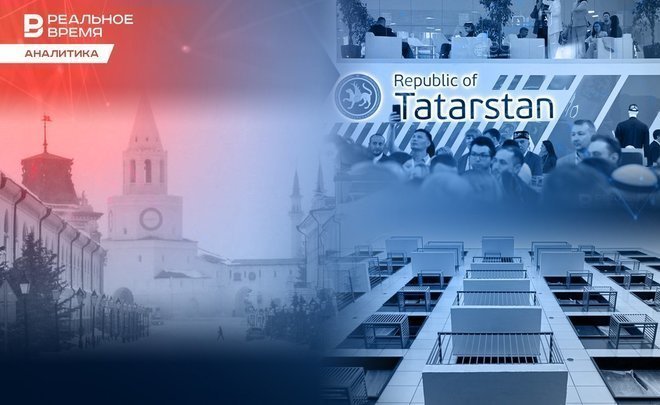Economic development of Tatarstan hampered by low oil prices

Tatarstan's economy remains one of the most stable in the Volga Federal District. In 2023, the republic retained its leadership in the construction and commissioning of housing and was in the top in terms of retail trade turnover. Besides, according to official statistics, Tatarstan has some of the highest salaries in the Volga region. However, Tatarstan unexpectedly found itself among the outsiders in terms of the dynamics of industrial growth. The analytical service of Realnoe Vremya has studied how the republic has developed in comparison with other regions of the Volga Federal District and what other indicators it lags behind.
Tatarstan's industry grew worse than everyone else in the Volga Federal District
The only weak link in Tatarstan in 2023 is the dynamics of industrial production, which continues to decline. According to Tatarstan Statistics, the index of industrial production in the republic amounted to 103% for 10 months of 2023 — this is the lowest indicator in the Volga Region.
Tatarstan unexpectedly found itself among the outsiders in this indicator. The five leaders in the dynamics of the industrial production index are the Chuvash Republic (126%), Mari El (119.5%), Penza Region (115.5%), Ulyanovsk Oblast (110.7%), and Nizhny Novgorod Oblast (110.5%).
Igor Koch, Doctor of Economics, Professor at the Kazan Federal University, explains that such low industrial indicators are due to that the republic showed very good growth in 2022. The faster the industry grows, the more difficult it is for it to grow further, and it is easier to develop from scratch," the economist explained.

Developers have broken records again
Tatarstan traditionally retains leadership in the Volga Federal District in the construction and commissioning of housing. The volume of construction work completed in 10 months of 2023 in Tatarstan amounted to 512.7 billion rubles. Bashkortostan is in second place (303.9 billion rubles), Nizhny Novgorod Region — third place (265.6 billion rubles).
In terms of housing commissioning, the republic is significantly ahead of other regions of the Volga Region.
Retail market has exceeded 1 trillion rubles
Consumer activity in Tatarstan is also very high. The volume of retail trade exceeded 1 trillion rubles in 10 months of 2023. Bashkortostan (997.8 billion rubles) and Nizhny Novgorod Oblast (887.8 billion rubles) are in second place in this indicator.
At the same time, the price increase in Tatarstan was moderate compared to a number of regions of the Volga Federal District. And the average salary is the highest in the region.
Salary became the highest in the Volga Federal District
The average salary in the republic, according to hh.ru , exceeds 50 thousand rubles (50,217 rubles), and the expected value is slightly higher — 53,291. According to SuperJob estimates, the demand for personnel in Tatarstan has increased 1.5 times over the year. The resumes have increased by only 14%, and the competition for a vacancy has decreased by a quarter. The most sought-after areas with the largest number of vacancies are manufacturing, construction, and retail.

Such indicators are more objective if they are considered in the medium or long term, the expert notes. Short-term indicators do not always reflect reality, as they often show a recovery in production that collapsed in previous years.
“This is like car sales in Russia: in 2022, there was a sharp drop in sales, and then the market began to recover, and there was rapid growth," he cites an example. “But if we compare the figures with those of 2019, the picture will be completely reversed.”
Tatarstan is a clear leader in construction, but it must be taken into account that the population of Tatarstan is about 4 million people, and, for example, 676 thousand people live in Mari El. According to the expert, it is incorrect to compare only the volume of construction, it is necessary to calculate the volume of construction per capita, then there will be more objective indicators.
For example, per inhabitant in January-October 2023, agricultural products in the amount of 126.7 thousand rubles were produced in Mordovia, 79.5 thousand rubles — in Saratov Oblast, 60.1 thousand rubles — in Tatarstan, 48 thousand rubles — in Bashkortostan.
“In terms of inflation, the difference in price growth to 1% is also a statistical error, the difference between the regions of the Volga Federal District is insignificant, so all this is quite conditional," Shayakhmetov believes.
“But the high wage in Tatarstan is a very significant factor determining the economic strength of the region and its well-being," the economist agrees. “Today, Tatarstan is a clear leader in the Volga Federal District and a powerful centre of attraction for the workforce.”
Is low oil prices to blame for the economic downturn?

In the total volume of GRP, 26% is mining, 17,5% is manufacturing, 10,4% is wholesale and retail trade, 7,7% is construction, 5,6% is transportation and storage, 4,3% is agriculture.
“Mining brings most of the added value in Tatarstan's industry, and many other manufacturing industries (oil refining and petrochemistry) are heavily dependent on it. All these three industries (mining, refining, petrochemistry), in turn, tend to depend on world oil prices," explains Bikbov.
The average price of Urals crude oil in 2023 was $62.99 per barrel, the Ministry of Finance stated. For comparison, in 2022 it was at the level of $76.09 per barrel. Average prices for oil and, as a rule, for its derivatives fell by 18% in 2023.
“The situation with the fall in oil prices was partially corrected by the devaluation of 2023," Bikbov notes. “The average annual exchange rate for the US dollar in 2023 was 85.16 rubles, and in 2022 it was 68.49 rubles, which is by 24% higher. But speaking of the foreign market, it has not always been possible to sell both oil and its derivatives at world prices (as we know, logistics has changed dramatically after the start of its development) and it has not always been possible to sell in convertible currencies. So, with a high degree of approximation, we can say that for the industrial triad of Tatarstan “production — refining — petrochemistry”, the year was very difficult and much worse than 2022. That is why there is a rather low growth in industrial production.”
But a 3% increase in industrial production is also very good, he believes. “We should not forget that the very structure of production in Tatarstan has been undergoing drastic changes in recent years — there has been a sharp increase in state defense orders, which stimulates an increase in production volumes in the sub-sectors of the military-industrial complex," the expert recalls. “The leaders among the industries in 2023 were the production of computers, electronics, and automobiles. So, the truck market alone showed almost 90% growth at once — from 75 to 140 thousand registered with the traffic police in 2023.”
Albert Bikbov notes qualitative changes in the structure of the republic's industry — it is becoming more diversified and less dependent on oil.
“There is an opinion that the low growth of industry rests on the so-called 'border of production capacities'. This is evidenced by record low unemployment in Tatarstan, and an acute shortage of personnel at enterprises," the economist says. “This is not quite true — it is not necessary to consider the industry in isolation, it does not exist in a vacuum, but works in the complex of the entire regional economy. For example, there is a personnel shortage in the manufacturing industry and a lack of personnel hunger in the service sector. For example, in delivery services, according to December, it was possible for couriers to earn 200 thousand per month. There is a flow of labour resources into companies where wages are higher.”